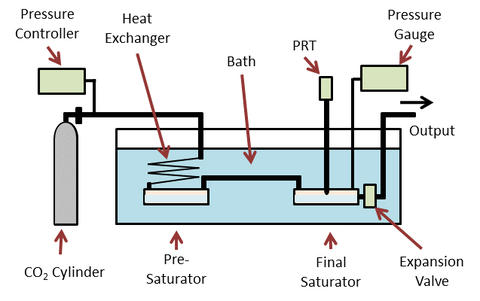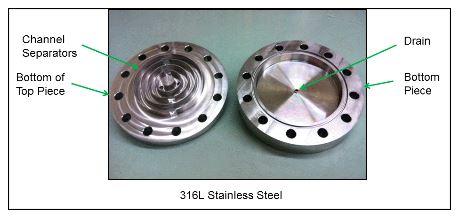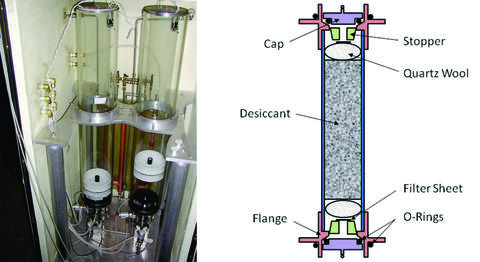Dew-point measurements for water in compressed gases

This project has been completed. The paper reporting the results is provided here. The NIST Thermodynamic Metrology Group (TMG) used its standard gravimetric hygrometer as part of a facility for making high-accuracy measurements of the dew point temperature for water in compressed CO2 as a function of mole fraction and pressure. Knowledge of this relation is important for the effort to perform Carbon capture and sequestration (CCS) in power plants.
NIST has developed a facility for determining the relation of the water dew point temperature TDP to the water mole fraction (x) and pressure (p) in a gas. This relation is a property that is important to industrial processes involving the gas. To relate TDP to x and p, a thermodynamic quantity called the water-vapor enhancement factor (fw) must be known. This quantity varies with both TDP and p.
One example of an industrial process in need of knowledge of this relation is Carbon Capture and Sequestration, which needed the knowledge for CO2. In this process, a sufficient amount of water must be removed from the captured CO2/H2O mixture before it is ready for compression, transport, and storage. Water condensation causes corrosion in the pipelines and other conventional carbon-steel materials that it contacts. Also, compression and transport of CO2 require more energy when it is moist. The simplest method for drying the captured CO2/H2O mixture is to cool it until sufficient water condensation occurs. Knowledge of fw(TDP,p) for CO2 is essential for designing this cooling process.
For determining fw(TDP,p) for a gas, the TMG has built a humidity generator that is capable of saturating the gas with water at pressures up to 7 MPa and temperatures from 1 °C to 85 °C. The generator features two high-pressure saturators. In these vessels, the gas flows over water inside a long channel, mixing the gas with water vapor at its saturated vapor pressure. Measurements of the temperature and pressure in the saturator yield TDP and p. The gas can be fully saturated at flow rates up to 6 L/min.

The gravimetric hygrometer measures the water mole fraction in the gas exiting the generator. It separates the water from the gas using desiccants and subsequently determines the masses of the water and the gas separately. These masses are then used to calculate the water mole fraction in the gas. The NIST gravimetric hygrometer is the only working gravimetric hygrometer in a National Measurement Institute today. It is capable of determining water mole fractions with an expanded uncertainty (k = 2) of 0.1%. The facility consisting of the humidity generator and gravimetric hygrometer is capable of determining TDP(x,p) to 0.01 °C.
The facility has been validated using air as the working gas. Its measurements of fw(TDP,p) for air agree to within the measurement uncertainties with the measurements made at NIST by Dick Hyland and Arnold Wexler in the 1970s, which are still considered the standard.

Measurements of fw(TDP,p) using CO2 were performed with this system and published (C.W. Meyer and A.H. Harvey, “Dew-point Measurements for Water in Compressed Carbon Dioxide”, AICHe J. 61, 2913 – 2925, (2015).). The measurements were made at five temperatures over the range 20 °C to 85 °C and at ten pressures over the range 1 MPa to 5 MPa at each of these temperatures. These measurements were used by NIST theorists in the Applied Chemicals and Materials Division to construct the interaction second virial coefficient for CO2-water mixtures enabling predictions of fw(TDP,p) over values TDP and p where measurements were not made.
Similar measurements may be performed using other gases of interest, and NIST is eager to learn of gases where such measurements would be valuable to industrial needs.

